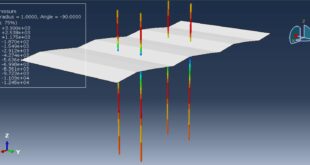In this tutorial, the Simulation RC column retrofitted with CFRP and epoxy under compression load in Abaqus has been done. The circular concrete column is modeled as a three-dimensional solid part. The sell strips and bars are modeled as three-dimensional wire parts. The CFRP is modeled as a conventional shell part with four layers. The epoxy is modeled as a three-dimensional solid part. Two rigid bodies as boundary zone and hydraulic jack are used. You can see figures for the assemble parts below

It is well known that a high percentage of existing structures in earthquake-prone regions of the world need to be strengthened for reducing the risk of heavy loss of life and economic losses. These structures were constructed according to older codes and/or inadequate construction practice. Particularly in developing countries, the seismic performance of the structures may be significantly poor due to insufficient ductility and low concrete strength. The structural members of this type of structure may experience severe damage due to the low deformability and axial capacity of the structural members. Jacketing vertical structural members with high strength CFRP composite sheets can enhance both deformability and axial capacity of the members significantly, as well as preventing the buckling of the longitudinal reinforcement. The introduction of advanced polymer composites in the civil infrastructure has been a very rapid process and the extraordinary properties of these materials have enabled the design engineers to have greater confidence in the materials’ potential and consequently to use them in various constructions including the strengthening of buildings
The model is a continuum, plasticity-based, damage model for concrete. It assumes that the main two failure mechanisms are tensile cracking and compressive crushing of the concrete material. To model concrete column CDP plasticity model is selected. The elastic-plastic model is used to define steel reinforcement behavior. Damage initiation refers to the onset of degradation at a material point. In Abaqus, the damage initiation criteria for fiber-reinforced composites are based on Hashin’s theory. To model CFRP fiber behavior Hahsin’s damage criterion is selected. The traction elasticity and damage criterion are considered for the epoxy glue
Both dynamic and static step is selected for this type of analysis separately. The embedded region constrain is used for the steel reinforcement in the concrete host. The perfect contact is assumed between CFRP-Epoxy and Column-Epoxy. The load is applied to the top rigid body and fixed boundary to the bottom plate. The mesh should be fine to obtain the correct results
After the simulation, all results such as stress, strain, tensile and compressive damage, epoxy failure, CFRP damage,…are available. You can see some figures for the results below







You can provide CAE, INP, and English video files of this simulation here. The cost of these files is Twenty-Six Euros. you can click on the bellow bottom to beginning the process
You can purchase the tutorial through a PayPal account, a Visa, or a Master card, just before payment, send me an email to this address: karampourp@gmail.com
 Abaqus tutorials Abaqus tutorials
Abaqus tutorials Abaqus tutorials




